
Even though water is the most solvent liquid and we think that its physical and chemical properties are the same everywhere, water cannot be homogeneous under certain conditions! What do you think? It may not be believable at first glance, but thermal stratification is a process that stratifies and makes water heterogeneous. The concept of thermal stratification in lakes began in the 1960s with analytical and laboratory studies. At that time, theories were presented for the time dependence between solar radiation and vertical temperature distribution (Dake and Harleman, 1969). After years, we see new horizons of thermal stratification, especially in lakes.
In this article, we will examine the phenomenon of thermal stratification in lakes, a process that includes a significant part of the world's lakes. Deep and large lakes such as the Caspian Sea, Tanganyika, Malawi-Nyasa, and Baikal, as well as medium and small lakes, are subjected to thermal stratification during the annual cycle, and vertical circulation of water does not occur in these lakes. The lack of vertical circulation of water in lakes leads to heterogeneous conditions and a lack of overturning. The thermal classification of lakes affects the distribution of dissolved substances such as oxygen and nutrients and affects the ecosystem and biodiversity living in the lake (George and Hewitt, 2006; Thackeray et al., 2006). Since thermal stratification is one of the qualitative characteristics of dams, lakes, and other water bodies, the effects of thermal stratification on lakes are examined in detail in this article.
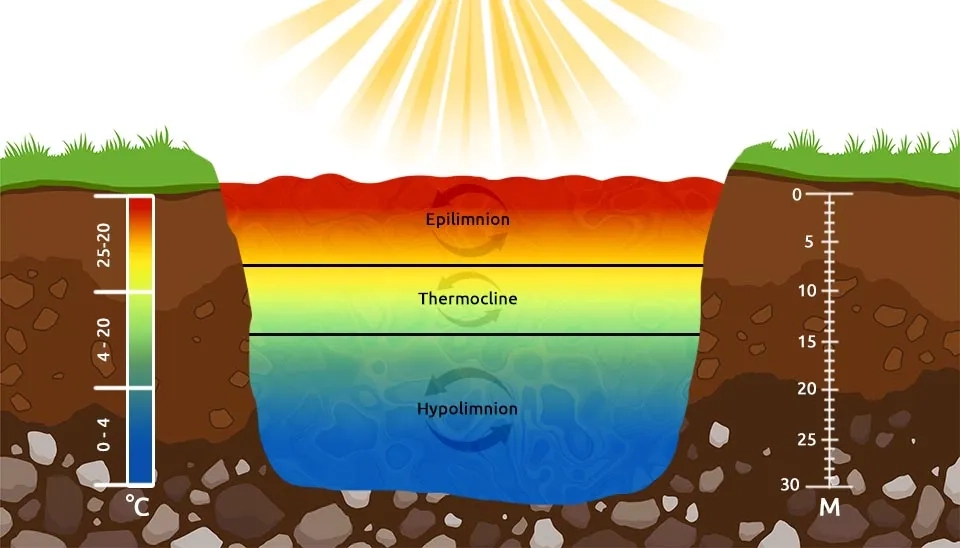
1. What is Thermal Stratification? (Formation of Thermal Stratification)
The world's lakes are exposed to different weather conditions during the year. Weather conditions in a year cause a temperature cycle and changes in the amount of solar radiation entering the earth (incoming solar radiation). Lakes located in the equator or near the North and South poles are subject to fewer temperature changes than other lakes due to fewer temperature changes and permanent ice cover on the lake. Climatic conditions and the contact of lakes with the atmosphere created stratification and currents in the lakes. As a result of solar radiation, a portion of the thermal energy is absorbed by the lake, and the rest is reflected depending on the albedo coefficient. Thermal contact with the atmosphere causes the surface temperature of the lake to increase, while the lower layers of the lake are protected from direct contact with solar radiation. The surface of the lake is heated by absorbing solar radiation, and as its temperature increases (exceeds 4 degrees Celsius), the water density decreases. As a result, the warmer water is placed on the surface at a limited depth. The difference in density between the surface layer of the lake and its deeper layers forms thermal stratification (Boehrer and Schultze, 2008).
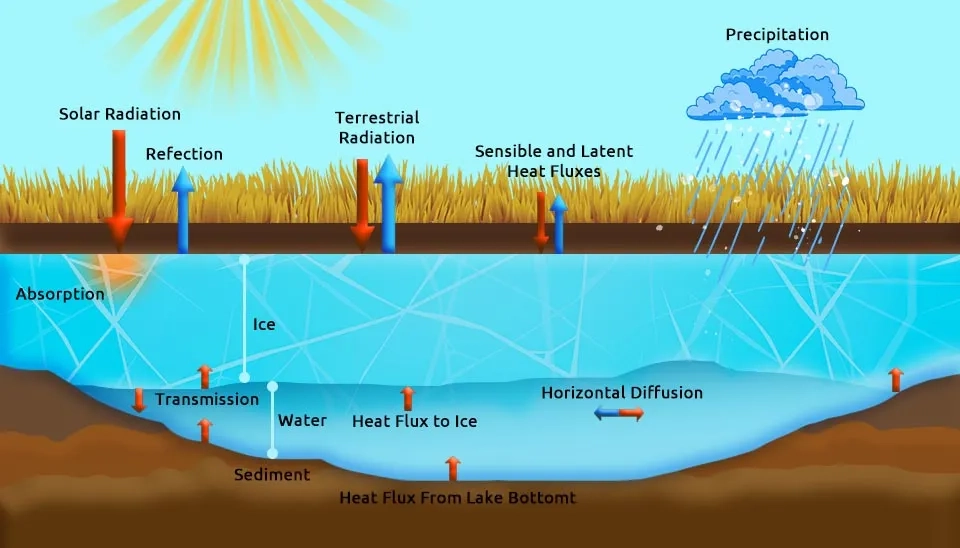
The increase in incoming solar radiation in summer starts the thermal stratification and continues until autumn and winter, when the surface temperature of the atmosphere and its exchange with the lake make it possible for water to circulate to deeper layers. On the other hand, the transfer of heat from the surface to the deeper layers of water is carried out by two mechanisms: diffusive heat transport and kinetic energy through wind stress. The role of diffusive heat transport is at the molecular level, and it takes a lot of time to reach the deeper layers. Wind stress plays a significant role in heat transfer, which requires wind on the surface of the lake. The absence of wind and the increase in surface temperature cause the formation of stratified layers along the depth of the water (Boehrer and Schultze, 2008; Dake and Harleman, 1969), which will be discussed in the next part.
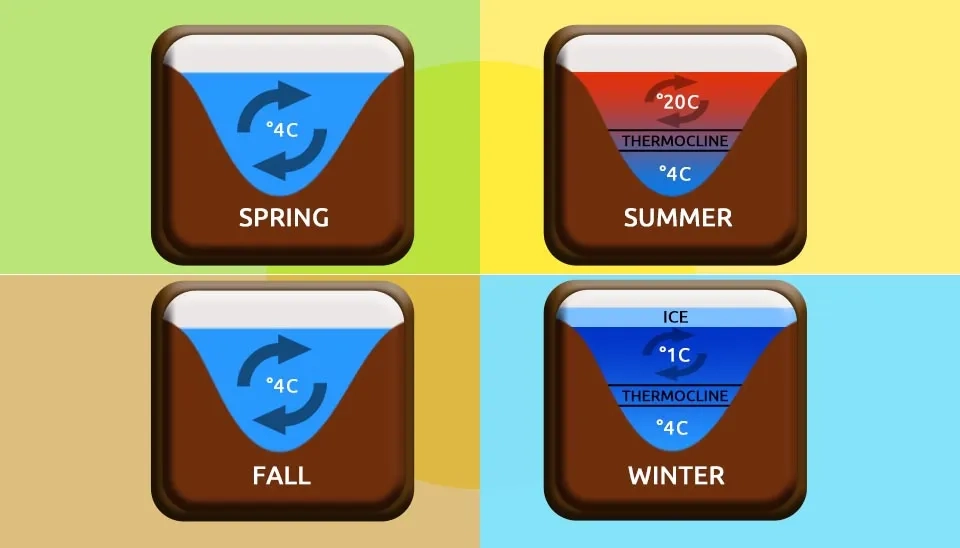
2. Epilimnion, Thermocline, and Hypolimnion
The thermal stratification in lakes consists of three layers: epilimnion, thermocline, and hypolimnion. Epilimnion is the upper layer next to the atmosphere; hypolimnion is the lower layer; and thermocline (or the so-called metalimnion) is located between epilimnion and hypolimnion. Due to the proximity of the epilimnion and the atmosphere, heat, gases, and volatile matter are exchanged with the lake through the epilimnion. The closeness of the epilimnion to the wind causes the epilimnion to be recirculated during the thermal stratification period, changing the thickness of the epilimnion continuously. On the other hand, hypolimnion is not exposed to atmospheric exchanges and endures more stable conditions (Boehrer and Schultze, 2008).
-and-hypolimnion-in-thermal-stratification-in-lakes-6797a6642fbc076f68ffe89e)
In the thermocline, the transport of soluble substances in the vertical direction is usually limited; however, chemical precipitation and the settling of particles are responsible for the transport of soluble substances in the thermocline. Since the thermocline layer is adjacent to the hypolimnion and epilimnion and benefits from the advantages of both layers, it is capable of adaptation and living organisms. Organisms that have the ability to adjust their density can be placed in the thermocline. The accumulation of living organisms and the decomposition of organic matter in the thermocline, especially in nutrient-rich lakes, reduce the oxygen concentration of the thermocline and cause a metalimnetic oxygen minimum. However, light penetration and photosynthetic processes compensate for the depletion of oxygen in the thermocline and prevent the complete consumption of oxygen. This process is common in mesotrophic lakes. The thickness of the thermocline can be several meters depending on the intensity of water heating and the temperature difference between epilimnion and hypolimnion, which contain a large amount of detritus, bacteria, and phytoplankton (Sadchikov et al., 2019).
When the temperature of the lake surface decreases, epilimnion and hypolimnion combine and form a layer. In this case, the lake is homogenized and is called mixolimnion. The main decrease in temperature occurs in the seasonal time scale (cold seasons), but in some cases, the decrease in temperature during cold nights can also lead to the homogenization of the lake. The formation of thermal stratification also depends on weather conditions and the depth of the lake. The closer the lake is to the equator and the lower its depth, the temperature difference between epilimnion and hypolimnion decreases due to low-temperature changes, and the lake is mostly in overturning mode (Boehrer and Schultze, 2008).
3. Classification of Lakes Based on Thermal Stratification
Lakes are divided into four categories from the point of view of thermal stratification patterns and circulation mechanisms (Lewis, 1983; Hutchinson, 1957):
Holomictic lakes: These lakes are homogenized and overturned at least once a year. Holomictic lakes are divided into polymictic and dimictic categories based on overturn time and frequency. Polymictic lakes are shallow lakes where hypolimnion does not form. In this case, an epilimnion is formed in the entire lake, which is homogenized and overturned due to temperature and wind throughout the day or year. In contrast, dimictic lakes are homogenized and overturned twice a year and are mainly located in moderate to cold climates.
Meromictic lakes: In Meromictic lakes, overturn does not occur in the entire lake. Meromictic lakes have a layer that is not overturned and remains chemically different during an annual cycle. Due to the formation of a stable and uncirculated layer, the meromictic lakes are deep anoxic layers (without oxygen) and accumulate nutrients (Tandyrak et al., 2021).
Episodic partial deep water renewal lakes: These lakes are similar to meromictic lakes, with the difference that despite recycling mechanisms, the lake remains stratified for a temporary or intermittent period (Boehrer et al., 2008).
Amictic lakes: Amictic lakes are located in cold regions that do not undergo deep recirculation due to weather conditions. The formation of ice cover causes the lake to overturn under the ice cover.
4. Effects of Thermal Stratification on Lakes
The formation of thermal stratification in lakes affects the physical, chemical, and biological characteristics of the lakes, causing negative and positive impacts on the lake. As discussed in the previous sections, thermal stratification changes the pattern of water circulation and temperature distribution. With increasing temperatures, biogeochemical activity is intensified under the influence of internal and external parameters, and aquatic ecosystems such as fish, zooplankton, phytoplankton, and other aquatic species are affected. In addition, temperature plays an important role in the dissolution rate of water-soluble gases such as oxygen and controls the vertical distribution of dissolved oxygen in the water column (Mihir et al., 2015).
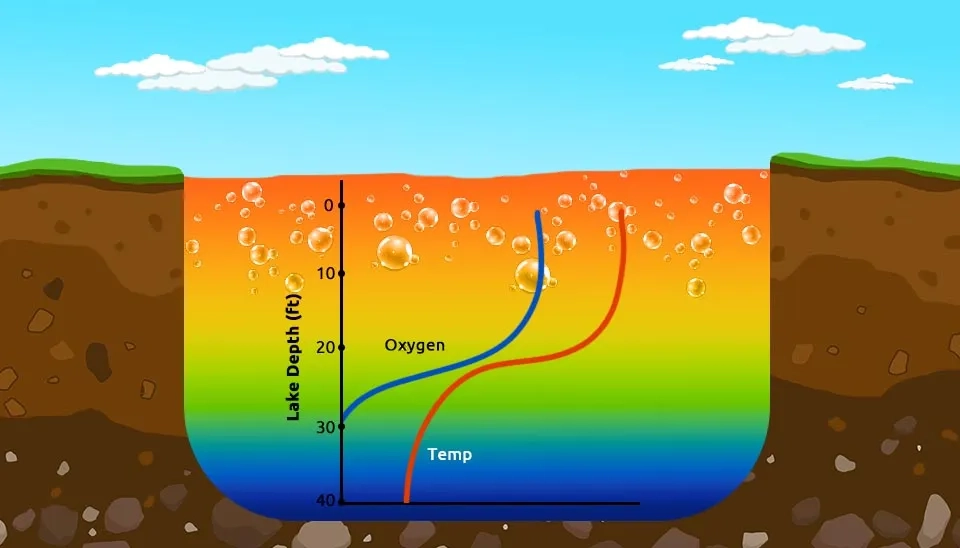
Thermal stratification can affect the oxygen concentration of lakes. As shown in Figure 5, temperature and dissolved oxygen decrease with increasing depth. The concentration of dissolved oxygen in water affects the quality of lake water, and by providing redox reactions, recycling organic material, and supplying oxygen needed by organisms, it is a key and controlling factor in the aquatic ecosystem. In hot seasons and periods when the lake undergoes thermal stratification, the oxygen concentration in the hypolimnion layer decreases and depletes, especially in eutrophic lakes. The reduction or depletion of oxygen concentration is called anoxia. Summer hypolimnetic anoxia is determined and aggravated by internal factors as well as external factors such as weather conditions and nutrient loads, that affect the water quality. The start of thermal stratification at the beginning of summer and the emergence of water vertical stability cause interannual variability in anoxia and control the duration and spatial extent of hypolimnetic anoxia (Ladwig et al., 2021).
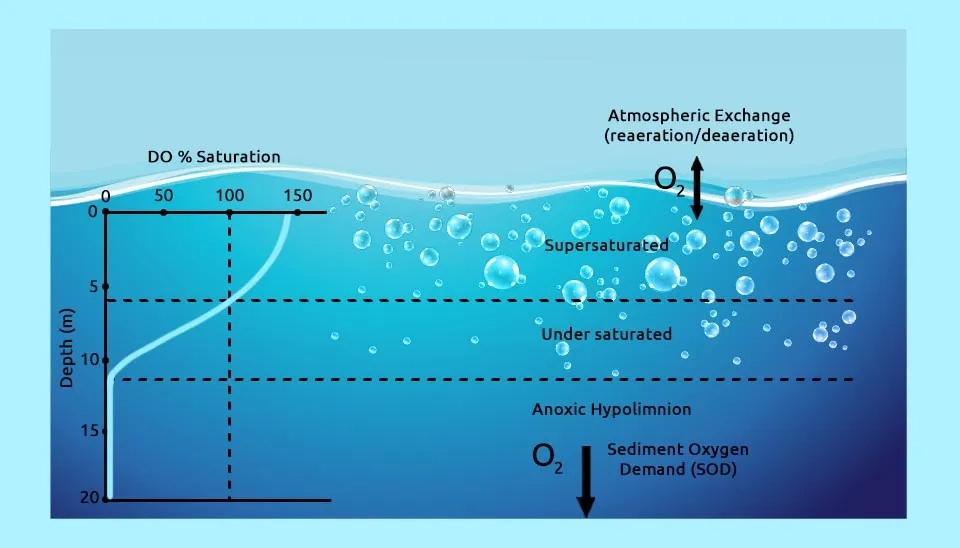
Thermal stratification and periods of anoxia can have significant consequences for fish habitat, nutrient dynamics, and greenhouse emissions. Previous studies show that in thermal stratification (with a lag of several days), dissolved oxygen is maximized at the surface, and the lake faces anoxia conditions at depths of more than 2 to 3 meters. Therefore, during the anoxia period, fishes and aquatic animals generally gather at depths of 2 to 3 meters. On the other hand, the concentration of phosphate, ammonia, and greenhouse gases increases at depths of more than 2 meters (Søndergaard et al., 2022). Continuation of hypolimnetic anoxia and the reduction of dissolved oxygen below 1 to 2 mg/liter in higher layers will cause the death of fish (Abdel-Tawwab et al., 2019).
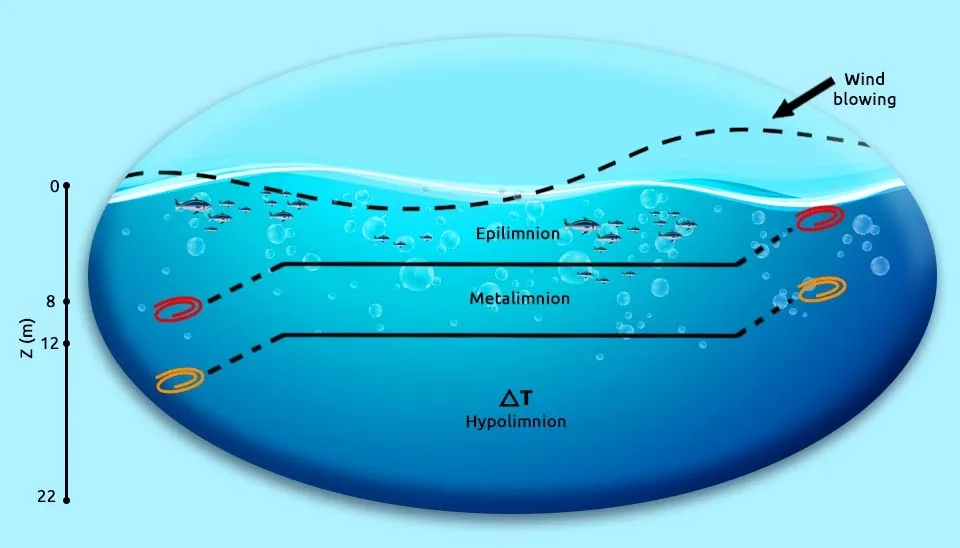
5. Conclusion
Thermal stratification is a process in which the lake is out of homogeneity and mixing and becomes so-called stratified. The fundamental factor in the formation of thermal stratification in lakes is incoming solar radiation, which causes the temperature of the lake surface to increase while the temperature of the lake bottom is low. Despite diffusive heat transport and kinetic energy through wind stress in the uniform distribution of temperature and compensating for the effect of solar radiation, we see the formation of thermal stratification in deep and large lakes all over the world. It is worth mentioning that thermal stratification is not limited to summer and hot seasons since it is also formed in cold seasons with the formation of ice cover on the surface of the lake. As a result of thermal stratification in lakes, three layers of epilimnion, thermocline (metalimnion), and hypolimnion are formed in the lake, which causes the heterogeneous distribution of physical, chemical, and biological properties in the water depth. The epilimnion layer is in the vicinity of the atmosphere and is considered a warm layer with a high concentration of oxygen, while the hypolimnion layer is the lower layer with the lowest amount of oxygen (anoxic condition). The thermocline layer is also a habitat for detritus, bacteria, phytoplankton, and other aquatic biodiversity due to the benefits of the upper and lower layers. Based on the pattern of thermal stratification and circulation, the lakes are divided into four categories (Holomictic, Meromictic, Episodic partial renewal lakes, and Amictic), which are different from the point of view of cycle (number of stratification times per year) and depth of stratification. In general, the effects of thermal stratification on lakes are caused by the heterogeneous distribution of temperature along the depth and the effect on other physical, chemical, and biological parameters. The thermal stratification causes hypolimnetic anoxia conditions and affects the vertical distribution of nutrient dynamics, greenhouse emissions, and fish habitat. This article expands our understanding of thermal stratification in lakes and helps to understand the hydrodynamic and thermodynamic behavior of lakes.
